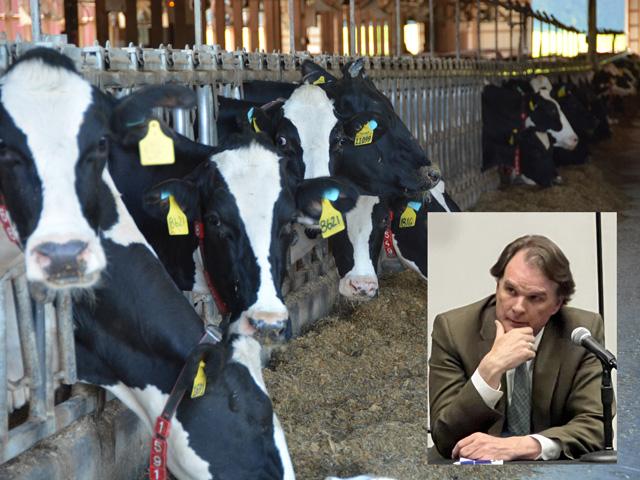Climate-Smart Spending and Livestock
USDA Undersecretary Rejects EWG Complaints Over Livestock and Climate Projects
OMAHA (DTN) -- USDA officials are disputing some of the complaints from environmental groups over climate mitigation dollars going to livestock producers.
Environmental Working Group issued a report last week, stating at least some climate-smart practices eligible for funding under the Environmental Quality Incentives Program (EQIP) "likely do little or nothing to help in the climate fight." EQIP received $8.45 billion under the Inflation Reduction Act (IRA) to fund on-farm practices that either help reduce greenhouse gas emissions or sequester carbon.
Breaking down 14 practices, EWG cited at least eight that either increased irrigation or helped concentrated livestock facilities such as funding for waste-storage facilities or biogas facilities.
"So, calling the livestock and irrigation practices climate-smart, provisionally or not, is problematic since the IRA states that its agricultural funding should go to conservation practices that reduce emissions or sequester carbon," EWG stated in its analysis.
USDA Undersecretary for Farm Production and Conservation Robert Bonnie refuted some of that criticism last week during a meeting at Commodity Classic in Houston about the Partnership for Climate-Smart Commodities.
"We strongly disagree with (the criticism) and we think it's really, really important to work with the livestock community," Bonnie said. "There are opportunities there for emission reduction and to find ways that we can take advantage of many innovations that have been in dairy and elsewhere."
Bonnie added, "Any effort to address climate-smart agriculture as the partnerships -- or anywhere else -- livestock producers are going to be a really important part of the equation," Bonnie said. "We need to work with them on mapping reductions and improved grazing."
P[L1] D[0x0] M[300x250] OOP[F] ADUNIT[] T[]
At least 15 Democratic members of Congress also oppose USDA for allowing "several industrial animal agriculture practices" be eligible for IRA dollars. Sen. Cory Booker, D-N.J., led a letter to USDA in early February raising complaints similar to EWG. The lawmakers complained that waste storage, biogas facilities and funding for feed management in livestock would mainly benefit confined animal feeding operations (CAFOs) "which do not meaningfully reduce the environmental impacts of these facilities."
Methane from livestock makes up about 4.5% of all U.S. greenhouse gas emissions, according to EPA. Some of the ways EPA cites to reduce those methane emissions are adjusting feeding practices and improving the storage and handling of livestock manure, such as using anaerobic lagoons to capture methane and convert it for energy to replace fossil fuels. California's Air Resources Board also provides incentives for using livestock methane as renewable natural gas in its low-carbon fuels standard.
The undersecretary added it's important to continue gathering data about which practices work and which will not. There also are some innovations expected in feed additives for livestock such as dairy cows that will help lower enteric emissions from cows.
"We funded a bunch of livestock practices and we anticipate that at some point we may have some feed additives to reduce some of the criticism you see from the environmental community around livestock practices," Bonnie said.
Chief of USDA's National Resources Conservation Service (NRCS) Terry Cosby said he had not had a chance to look at the EWG report, but said USDA looks at its practices based on science.
"We're going to continue to do the research and look at new technology," Cosby said, adding, "A lot of those practices were provisional practices so we're going to continue this process and looking at how what we are doing is science-based."
To gauge the value of climate-smart practices, USDA is spending $300 million to develop standards for measuring, monitoring, reporting and verifying on-farm practices that lower greenhouse gases or sequester carbon in the soil.
USDA operates in two separate, yet parallel tracks when it comes to climate-smart conservation. One area involves 140 pilot projects under the Partnership for Climate Smart-Commodities. The second area comes from the $19.5 billion set aside for USDA's major conservation programs from the IRA.
Talking about the partnership projects, which include more than 200 on-farm practices, Bonnie said there has been "relatively little pushback" on those projects by environmental groups. "I think just the quality of the projects -- I don't there has been a lot of the kind of practices there."
The partnership has a goal of enrolling 25 million acres over five years. So far, the pilot projects have enrolled about 1 million acres in 2023. Bonnie said he thinks 2024 will be a significant year for getting farmers to enroll in those projects.
"We're really excited about this. We think this is the year the rubber hits the road," Bonnie said. "We're going to see a lot more producers on the ground really putting these practices into place."
Also see, "SAF Credits for Biofuels Likely Tied to On-Farm Climate-Smart Practices," https://www.dtnpf.com/…
Chris Clayton can be reached at Chris.Clayton@dtn.com.
Follow him on X, formerly known as Twitter, @ChrisClaytonDTN
(c) Copyright 2024 DTN, LLC. All rights reserved.




